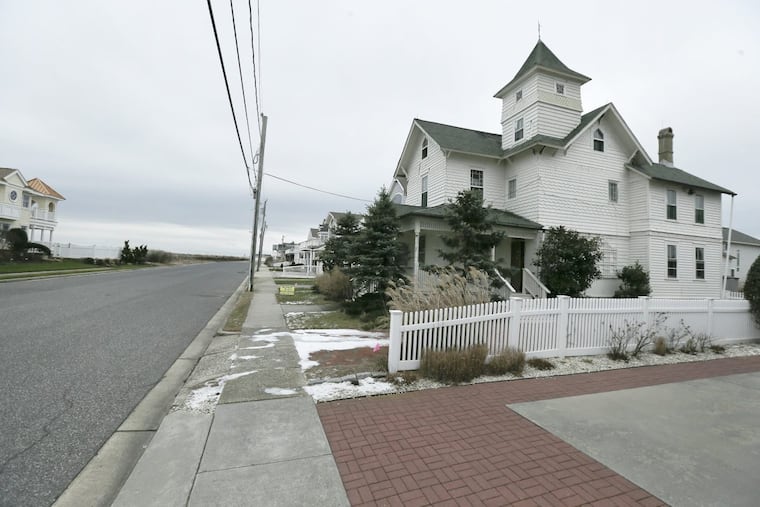At Shore, a last-minute effort to save an old house has odds stacked against it
"Avalon is all high-end homes and no history."

On Avalon's northern-most tip, aloof from the borough's million-dollar mansions, sits a Victorian estimated to have been built in 1895, with a widow's peak, cupola overlooking the ocean, and stained-glass windows.
Some see the house as one of the last vestiges of the island's charming past, before investors wiped out much of the beach town's old character.
Now the house's fate may be sealed. In October, a developer bought it at auction for around $1.1 million, and a February demolition date looms.
"This is one of the last remaining old homes in Avalon," said Chris Dean, a 62-year-old deck builder living in Wyncote, Montgomery County, who is leading a last-ditch campaign to salvage the summer home that his parents bought in 1955. In 1996, the couple sold it to a new owner who restored the interior, but who later sent the house into foreclosure.
The residence is one of only about 30 built in or before 1900 still standing in Avalon, a borough official said.
The developer, Jerry Raffa, plans to demolish the house at 254 Sixth St. and replace it with a two-story, single-family home with a swimming pool. He expects to spend around $800,000 constructing the residence.
Dean's proposal? He wants the borough to buy the house from Raffa and move it two miles south next to the Avalon History Center, a museum run by the historical society.
Dean presented the idea to the historical society and borough officials this month. He estimates that the move would cost $100,000. Dean said he is drafting a letter to the developer while other residents spread the word.
The house isn't on the state's Register of Historic Places, but it holds memories nonetheless. The borough's first tax collector, George W. Kates, built it three years after the borough's founding. On the third floor, Dean said, messages dating back to 1949 are written on the walls by past vacationers.
For some longtime residents, the house represents an era before redevelopers began tearing down the borough's quaint cottages to build large, multistory residences amid housing booms in the 1970s and 2000s. The average house price in Avalon is now $1.06 million, according to U.S. Census data, and the island is nearly empty during the winter.
"Avalon is all high-end homes and no history," Dean said. "This is something the town can rally behind."
Still, the last-minute efforts are likely in vain.
Borough administrator Scott Wahl said there are too many hoops to jump through to save the house before February, including passing an ordinance and approving a budget earmarking funds for the project. He said the borough was notified on Dec. 11 about the family's desire to preserve it. Dean said he left unreturned voice mails for Wahl over the summer.
Preservation in Avalon, Wahl said, typically is pursued by homeowners.
While Raffa said the plan could save him $15,000 in demolition costs, he does not expect the borough to finalize plans to move the house by February.
In an email, Avalon Historical Society president Robert Penrose said the organization lacks the resources to maintain entire houses. He, too, said most historic residences in Avalon are preserved by their owners.
But concerns stretch beyond 254 Sixth St. Some who own property in Avalon worry their old homes could be next to fall to developers if they sell.
Gail Quinn, 66, resides in Avalon during the summer in a Harbor Street house built in 1938 and bought by her parents in 1953. Fearful that developers would raze the building if she sold it, Quinn said she plans to pass it on to her children.
"If I ever sold it, it would immediately be knocked down and replaced with a mega house," said Quinn, who is sharing Dean's story with others in hopes it will renew a desire to preserve Avalon's history.
Compared with Cape May, Avalon and other nearby Shore towns present a stark contrast. Over many decades, the two towns set off on divergent paths.
A handful of Cape May activists and officials set out in the 1970s to maintain older structures by applying for federal urban renewal grants and hiring consultants tasked with helping residents preserve their homes. Chunks of the town were designated as historic. With blocks of homes and hotels dating to the 1800s, Cape May succeeded.
"Even a perfectly lovely, livable 1950s home in Avalon will be demolished to put up a new million-dollar mansion. The interest in preservation isn't there," said Greater Cape May Historical Society vice president Harry Bellangy.
Cape May's protection of more than 600 buildings is almost entirely thanks to a national historic landmark designation granted in 1970 and accepted by preservationist Mayor Bruce Minnix six years later, Bellangy said. Whereas Avalon is nearly empty in winter, Cape May's historic designation has helped extend the town's tourism season into December, when candlelight tours are offered in some Victorian homes.
Several old Cape May homes were relocated with the help of private individuals in the 1970s, including what's known as "the Pink House," built in the late 1800s and moved about 350 yards to Perry Street.
While most preservation efforts in Avalon are pursued by individuals, Wahl said, the borough in the 1990s preserved a "hose house" at 30th and Dune Streets owned by the fire department and built in 1912. He said the borough has only three sites listed on the state's register of historic places: a bridge, a life-saving station, and a wreckage site.
For Raffa, unaware of the history of the house at 254 Sixth St. when he bought it, it came down to this: "We're not Cape May. … If I didn't buy it, another developer would have."